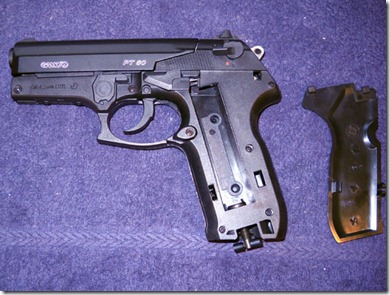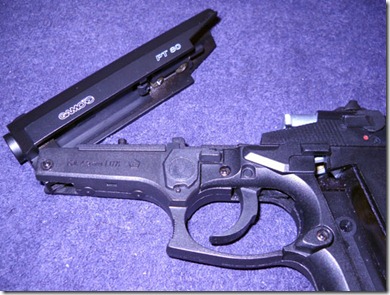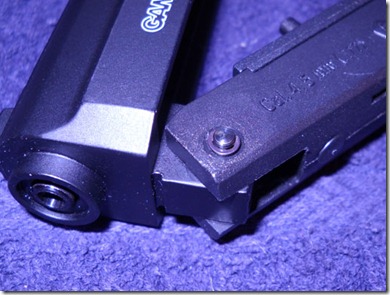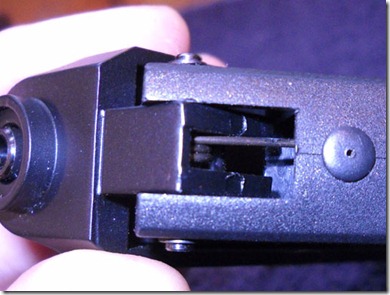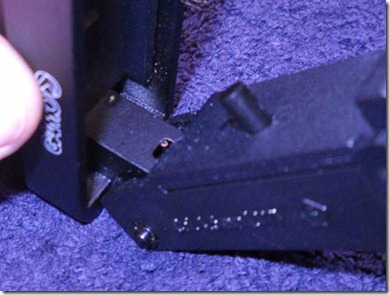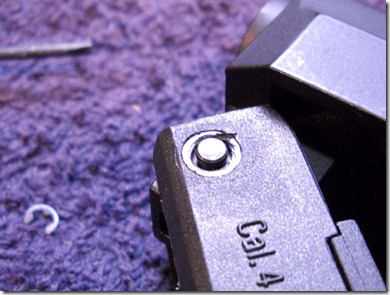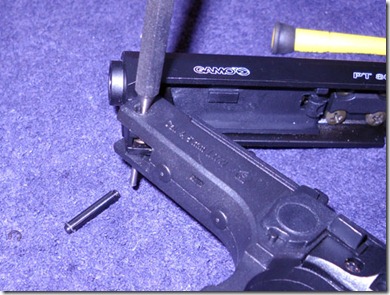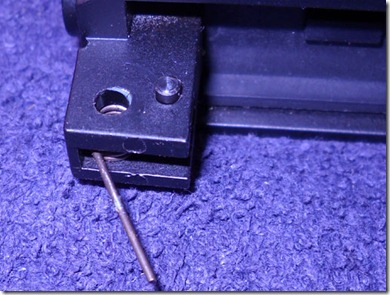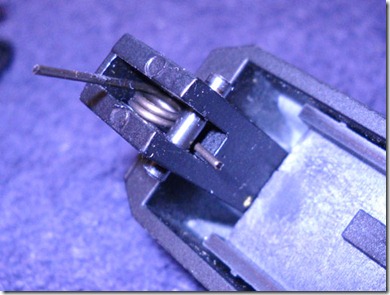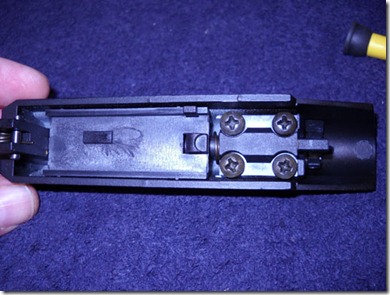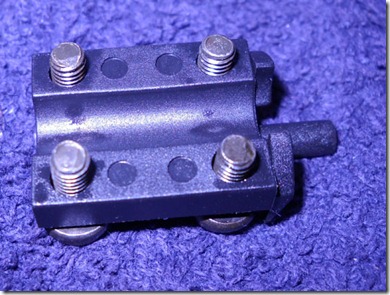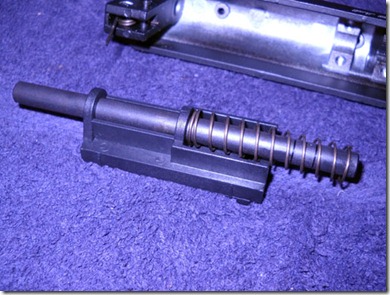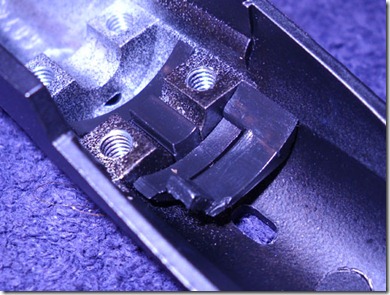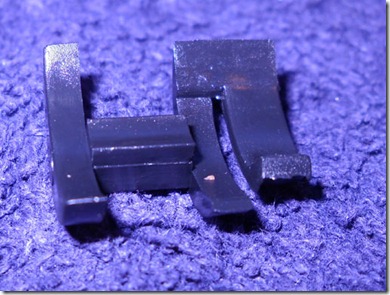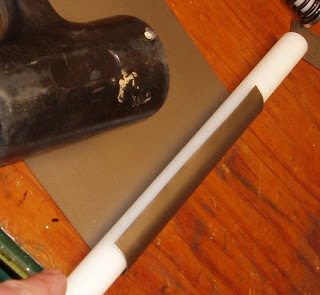While I have heard of German airgun pistol manufacturer FB Record, I'm mostly familiar with their compact "Jumbo" model pistol--a single shot spring piston gun. The "Champion" model is another gun altogether. The
Blue Book info for this pistol is almost completely incorrect. It's listed as a single shot, top lever--similar to a Beeman P1 /Weihrauch 45. In fact, the Champion is actually a twelve shot, magazine fed, spring-piston side lever. Yeah. Got all that? There's almost zero information out there for this model, so maybe this will encourage someone to post a comment or two about it.

I found the gun NIB with the original manual as well as a supplemental brochure from Great Lakes Airguns. The RWS "Squirrel" pellets didn't come with the gun. The hole for the tin was empty. Grips look to be rather plain beech(?).

The Champion pistol comes with a 12-shot clip and a small rod to aid in clearing a jam.

The gun is marked "West Germany" but I think they just didn't change the stamp after the Berlin wall came down in 1989. Great Lakes Airguns had ads in U.S. Airgun Magazine for the FB Record Jumbo throughout most of 1997--so I think the Champion was made a bit earlier than the Blue Book's date of 2001. I'm probably wrong, but I'll guess that these were made around 1998--1999.

The gun is made up mainly of castings. The manual lists the barrel as being 193mm--about 7.6 inches long--and notes that it is choked. They claim to have tested the gun at 10 meters. No test target came with the gun. An 11mm dovetail runs the length of the top and permits adding a red dot or pistol scope.

The left side has the slim side lever running full length.

Ready? Here's the weird part: the 12-shot magazine. There's a Euro heel-type mag release.

Odd looking thing.

The mag well is not funneled like a .45 auto race gun. The mags are very finicky about how they're loaded.

The mag only accepts diablo shaped .177 cal pellets. The manual specifically notes that the mag must be fully loaded with 12 pellets to ensure reliability. I've not found this to be the case. Down loading with 2 or 5--or whatever--hasn't caused a single feeding issue. Manual also mentions using "RWS Master" or "H&N match"-type pellets of "top quality". The mags are a huge pain to load. I've found that the easiest way is to hold the mag horizontally, pull the mag slider to the rear, then roll the mag to about a 45 degree angle with the loading port away from me so the pellet heads are angled down. Drop a pellet into the center loading post and allow the slider to advance it in the mag body. Pull the slider back and repeat. It's a slow process at first as the pellets sometimes flip around in the port then have to be fished out. I'm pretty good at it now, but there's a learning curve that's rather frustrating. There is no possible way to fire a pellet without first loading it into the magazine.

Another view. Ever seen a side loading port on a magazine before?

There's the follower spring.

Right side view. The "feed lips"--for lack of a better term--just barely holds the uppermost pellet in place. Because of that, it's really hard to attempt to load the mag from the top like a normal handgun magazine.

There's a spring-loaded catch on the left side that retains the cocking lever.

Press the latch down and swing out the lever.


It pulls out and catches at approximately ninety degrees.


The cocking lever and linkage are steel.

Some moly or similar grease on the linkage would probably help.

Just more views. The gun cocks with what feels like about 10 pounds of effort. It's a really smooth and light effort. The gun must be cocked--with the lever left in the open position--before inserting a loaded mag. The cocking lever is connected to a bolt loading mechanism on the return stroke. Each time the lever is closed, it automatically loads another pellet into the breech.

Rear sight is simple and well designed. It adjusts for windage and elevation.

Top strap is serrated to eliminate glare.

I wondered how close the Champion was in size to a P1. Pretty darn close.
Shooting the Champion is really nice. The 2-stage trigger is comfortably wide. I don't see any adjustment screws, but it's breaking consistently at just under two pounds. The manual says "hair trigger"--it's not quite that, but it's very, very easy to hang at the end of the first stage until the sights are perfectly aligned with the bull then release the shot. There's zero creep in either stage and I find the gun to be more comfortable to shoot off hand than a P1. The trigger isn't as good as the P1, but there's less spring torque, less twist, in the gun as it fires. A definite pulse and some minimal movement, but it's not as sharp as the Weihrauch. No doubt this is due to the lower power the gun produces.
Cycle the cocking lever, aim, fire. Cycle the lever, aim, fire...It's addictive. I think a good shooter could shoot 1" or even slightly smaller 5-shot off hand groups at 10 meters with this gun. Even in my shaky, unskilled hands, the accuracy is apparent.
Ten shots across the chronograph with RWS Hobby pellets gave an average of 362.2 fps. The extreme spread was 23.5 fps.
I'd love a set of the stippled walnut grips shown on the last page of the manual. There was a note inside about them being of "wallnut-tree" and made to order. I'll keep looking but I'm not exactly holding my breath.

